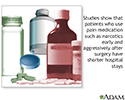Post surgical pain treatment - adults
Postoperative pain relief
Description
Pain that occurs after surgery is an important concern. Before your surgery, you and your surgeon may have discussed how much pain you should expect and how it will be managed.
Several factors determine how much pain you have and how to manage it:
- Different types of surgeries and surgical cuts (incisions) cause different types and amounts of pain afterward.
- A longer and more invasive surgery, besides causing more pain, can take more out of you. Recovering from these other effects of surgery can make it harder to deal with the pain.
- Each person feels and reacts to pain differently.
Controlling your pain is important for your recovery. Good pain control is needed so you can get up and begin to move around. This is important because:
- It lowers your risk of blood clots in your legs or lungs, as well as lung and urinary infections.
- You will have a shorter hospital stay so that you go home sooner, where you are likely to recover more quickly.
- You are less likely to have lingering chronic pain problems.
Your Role in Controlling the Pain
There are many types of pain medicines. Depending on the surgery and your overall health, you may receive a single medicine or a combination of medicines.
Studies show that people who use pain medicine after surgery to control pain often use fewer pain medicines than those who try to avoid pain medicine.
Your job as a patient is to tell your health care providers when you are having pain and if the medicines you are receiving control your pain. Providers will always be busy, but do not worry about bothering them. Speak up. In the end, you are the one in control of your pain.
Patient Controlled Anesthesia (PCA)
Right after surgery, you may receive pain medicines directly into your veins through an intravenous (IV) line. This line runs through a pump. The pump is set to give you a certain amount of pain medicine.
Often, you can push a button to give yourself more pain relief when you need it. This is called patient controlled anesthesia (PCA) because you manage how much extra medicine you receive. It is programmed so you cannot give yourself too much.
Epidural Pain Control
Epidural pain medicines are delivered through a soft tube (catheter). The tube is inserted into your back into the small space just outside the spinal cord. The pain medicine can be given to you continuously or in small doses through the tube.
Epidural pain medicines
Spinal and epidural anesthesia are medicines that numb parts of your body to block pain. They are given through shots in or around the spine....
You may come out of surgery with this catheter already in place. Or a doctor (anesthesiologist) inserts the catheter into your lower back while you lay on your side in the hospital bed after your surgery.
Risks of epidural blocks are rare but may include:
- Drop in blood pressure. Fluids are given through a vein (IV) to help keep your blood pressure stable.
- Headache, dizziness, difficulty breathing, or seizure.
Pain Pills or Shots
Narcotic pain medicine taken as pills or given as a shot may provide enough pain relief. You may receive this medicine right away after surgery. More often, you receive it when you no longer need epidural or continuous IV medicine.
Ways you receive pills or shots include:
- On a regular schedule, where you do not need to ask for them
- Only when you ask your nurse for them
- Only at certain times, such as when you get up out of bed to walk in the hallway or go to physical therapy
Most pills or shots provide relief for 4 to 6 hours or longer. If the medicines do not manage your pain well enough, ask your provider about:
- Receiving a pill or shot more often
- Receiving a stronger dose
- Changing to a different medicine
References
American Society of Anesthesiologists Task Force on Acute Pain Management. Practice guidelines for acute pain management in the perioperative setting: an updated report by the American Society of Anesthesiologists Task Force on Acute Pain Management. Anesthesiology . 2012;116:248-73. PMID: 22227789 www.ncbi.nlm.nih.gov/pubmed/22227789 .
Hanna MN, Ouanes JP, Tomas VG. Postoperative pain and other acute pain syndromes. In: Benzon HT, Rathmell JP, Wu CL, Turk DC, Argoff CE, Hurley RW, eds. Practical Management of Pain . 5th ed. Philadelphia, PA: Elsevier Mosby; 2014:chap 18.
Sherwood ER, Williams CG, Prough DS. Anesthesiology principles, pain management, and conscious sedation. In: Townsend CM Jr, Beauchamp RD, Evers BM, Mattox KL, eds. Sabiston Textbook of Surgery . 18th ed. Philadelphia, PA: Elsevier Saunders; 2012:chap 16.
-
Pain medications - illustration
After surgery many types of pain medications can be used such as opiates or narcotics, local anesthetics, and anti-inflammatory medications. Depending on the procedure and clinical situation, a single medication or combination of medications may be used.
Pain medications
illustration
-
Pain medications - illustration
After surgery many types of pain medications can be used such as opiates or narcotics, local anesthetics, and anti-inflammatory medications. Depending on the procedure and clinical situation, a single medication or combination of medications may be used.
Pain medications
illustration
-
Low back pain
(Alt. Medicine)
-
Anxiety disorders
(In-Depth)
-
Myocardial infarction
(Alt. Medicine)
-
Diabetes - type 2
(In-Depth)
-
Diabetes - type 1
(In-Depth)
-
Kidney stones
(In-Depth)
-
Hodgkin disease
(In-Depth)
-
Scoliosis
(In-Depth)
-
Stroke
(In-Depth)
-
Stroke
(Alt. Medicine)
Review Date: 7/26/2015
Reviewed By: Dale Mueller, MD, Cardiovascular and Thoracic Surgeon, HeartCare Midwest; Chairman Department of Cardiovascular Medicine and Surgery, OSF St. Francis Medical Center; and Clinical Associate Professor of Surgery, University of Illinois, Peoria, IL. Review provided by VeriMed Healthcare Network. Also reviewed by David Zieve, MD, MHA, Isla Ogilvie, PhD, and the A.D.A.M. Editorial team.

